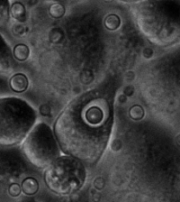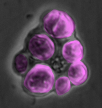Projects
We work on several pathogens within the group. Several of us work on fungi belonging to the genus Cryptococcus. These are widespread environmental fungi, but can cause a lethal brain infection in people with impaired immunity. They are particularly adept at ‘hijacking’ our own white blood cells, which is something we are particularly interested in understanding more about.
More recently, we have started working on Prototheca, a very unusual eukaryotic pathogen of humans and other animals (particularly cattle) and on a variety of complex co-infections. Read more about these below…

Vomocytosis
On the left, the fatal fungus Cryptococcus neoformans is escaping from a macrophage (a type of white blood cell) by a process called vomocytosis (you can also find out more on the vomocytosis Wikipedia page). Below, you can see the macrophages response – ‘actin flashes’ that act to trap the fungus inside the immune cell.

One of the big questions about vomocytosis is how it is influenced by inflammation. We recently found the first piece of this puzzle, by showing that pathogen expulsion is directly regulated by a signalling molecule called ERK5. You can read more about that in our recent Science Advances paper
Prototheca
We also have an interest in some pathogens which are, quite frankly, bizarre. We’re particularly interested in the Prototheca. These beasties have evolved fairly recently from algae. However, instead of photosynthesising, they are pathogens of mammals, including humans. Prototheca cause mastitis in cattle, so we are investigating where they come from and how they cause disease, with the hope of eventually reducing the economic cost of this infection in the dairy industry. Investigating pathogenesis mechanisms in this species might also reveal some fundamental ‘rules’ that determine how pathogens evolve from non-pathogenic ancestors.

Co-infections

We’re also very interested in how our immune system deals with complex threats, like co-infections with two different organisms at the same time. On the left you can see a human macrophage tackling a dual infection with Cryptococcus (red) and the measles virus (green).